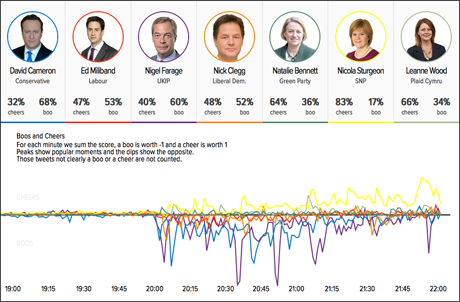
Twitter has long been a platform for live commentary and conversationa round set events, with the recent leaders' debate for the UK general election clocking up more than 1.5 million tweets from almost 280,000 people.
When that averages out at 8,657 tweets per minute on the hashtag #leadersdebate, trying to look for patterns or trends can be like catching a glass of water in a hurricane. Thankfully, the Centre for the Analysis of Social Media (CASM), a collaboration between think-tank Demos and the University of Sussex, along with pollsters Ipsos MORI, is developing tools to automate the process.
"Twitter is a whole new cognitive space that plays by its own rules and laws which we don't really understand yet," Carl Miller, research director at CASM, told Journalism.co.uk. "The whole idea of this project is to build new research methods for social media, to try and move the picture we have on from just listening to attitudes online."
The project has already produced various Twitter sentiment analysis graphs for media outlets, the most recent being an analysis for the Telegraph on the seven-way leader's debate.
And Miller said there should be further academic research into Twitter sentiment analysis, much more like the methodology behind opinion polls.
"We eventually want to put this in the arsenal of ways we can understand society, to make it complementary to conventional polling," he said. "This could add greater context, return results more quickly and help explain why polls are the way they are.
"Social media research allows you to see reactions in real time, as they are occurring, meaning they can begin to inform the phenomena that is being studied immediately. It's opening up all these new possibilities where this research can be useful."
One hope is that this research will allow journalists to better engage with social media content by explaining how emerging technologies may be applied to a variety of different areas.

Screenshot from Telegraph.co.uk
"I think it's incredibly exciting," continued Miller. "These social media sets are the richest source of behavioural evidence about society we have ever had. They're enormous, they're constantly refreshing and relatively unmediated.
"Twitter polls will never be as representative as a conventional poll but it is a whole new look into into public attitudes, bringing with it its own strengths and weaknesses."
Alex Krasodomski, a researcher for CASM, told Journalism.co.uk how their Twitter sentiment analysis software is a "human-led, machine-learning algorithm".
The software is given a selected set of tweets labelled as positive and negative and will use their composition – certain keywords, emoji, patterns in tweet structure or syntax – as the basis for judging future tweets.
It will then flag any tweets it does not understand, because of sarcastic or convoluted language, for example. Researchers categorise these new tweets, feeding back into the sorting criteria and helping the cycle continue.
"The whole reason we use these algorithms is to take impossibly large sets of data and make them understandable for ordinary people," said Krasodomski.Twitter has been recognised as a political battleground worth winningAlex Krasodomski, CASM
"In terms of technology, one of our aims is to make that a possibility, to bring an academically viable means of looking at social media to people like journalists so they can analyse them as they happen on Twitter.
"Twitter isn't a polling tool as such. It's much more a reactive medium, a different type of observation with its own set of pros and cons. It doesn't come as a massive surprise when a Twitter poll is very different to one done by YouGov. They're very different entities."
While there are currently no plans to release a publicly available program, the team hope to one day develop 'citizen dashboards' in partnership with media organisations and other benefactors.
"When we wrote a piece online about MPs who don't just use Twitter to broadcast but actually use it to interact with constituents and other interested parties, those who did well were keen to get that out there," Krasodomski added. "Twitter has been recognised as a political battleground worth winning."
Free daily newsletter
If you like our news and feature articles, you can sign up to receive our free daily (Mon-Fri) email newsletter (mobile friendly).









